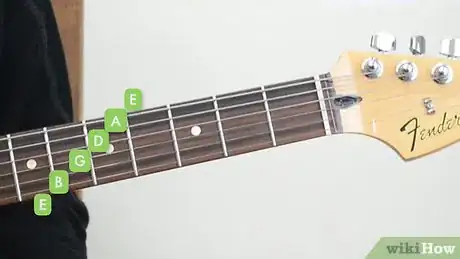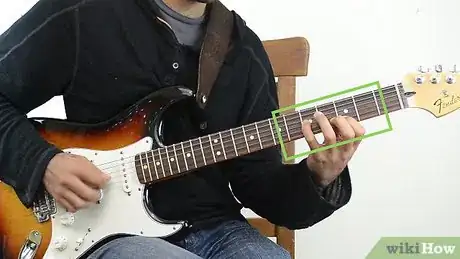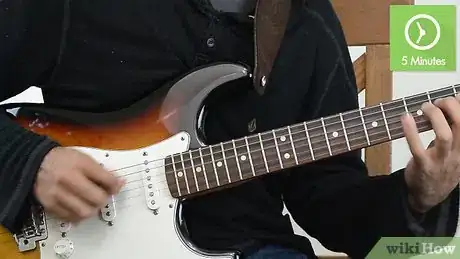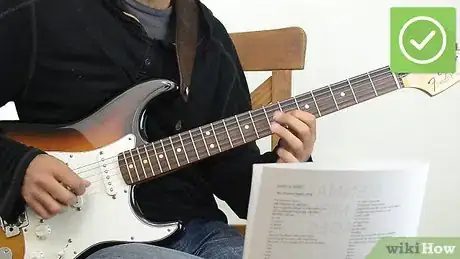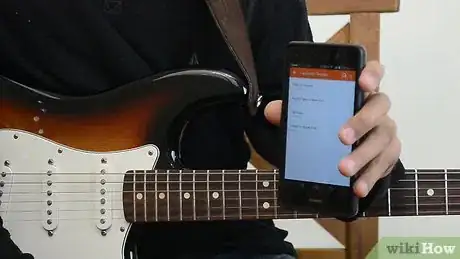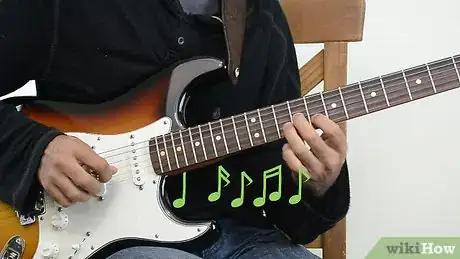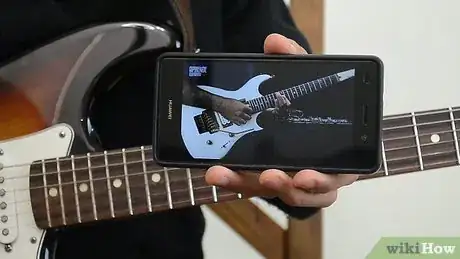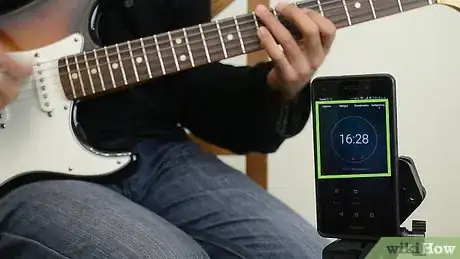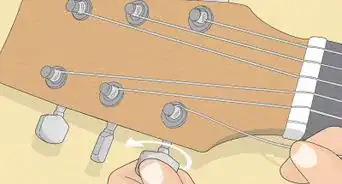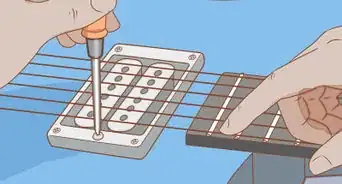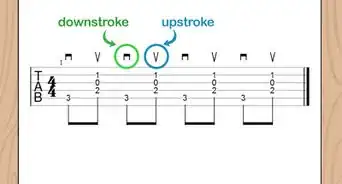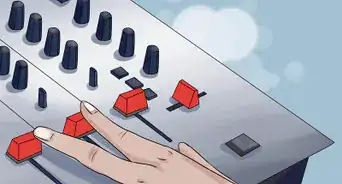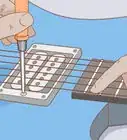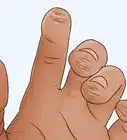This article was co-authored by Nicolas Adams. Nicolas Adams is a 5th generation musician of Serbian Gypsy descent and the lead guitarist of the band Gypsy Tribe. Based in the San Francisco Bay Area, Nicolas specializes in Rumba Flamenco and Gypsy jazz and playing the guitar, Bouzouki, Balalaika, and piano.
There are 12 references cited in this article, which can be found at the bottom of the page.
This article has been viewed 61,223 times.
Have you ever wondering what it takes to become good at guitar? Guitar playing is a skill that's not too complicated to start, but difficult to master. It starts with learning the basics; then it's just a matter of diligent practice, and expanding your knowledge. Put in the effort, and you'll see the results. Start today, and you can be on your way to becoming a skilled guitarist.
Steps
Learning Chords and Scales
-
1Recognize the string order on a guitar. To get better at playing guitar, it can help to be aware of each string on your guitar and their corresponding note. This will allow you to learn chords and scales in the future and get better at learning how to play songs. We are going to be discussing the string order on a standard six string guitar. Seven string and eight string guitars will have a different string order.[1]
- The top string is the thickest string and it is E. The order then goes from the thickest string E, to the thinnest string, low e. The order is: E, A, D, G, B, e.
- It may be tricky to remember the string order so you can use the anagram, Eat All Day, Go to Bed Early.
-
2Practice basic chords. Learning how to play chords will do two things: it'll get your fingers used to the guitar, and it'll allow you to play at least a simplified version of pretty much any song. You should look up chords for right handed players if you play with your right hand and chords for left handed players if you play with your left hand.[2]
- Start by playing guitar chords very slowly. Take your time and try to play each note clearly. Practice holding the strings down and making the chord shapes. Try to hold the chords with your non-dominant, or non-playing hand and strumming the strings with your dominant, playing hand.[3]
- You may start by following chord diagrams, online or printed out on paper, to help you visualize the basic chords. The chord diagrams will label each string with their corresponding note (E, A, D, G, B, e) and the order you are playing the notes to make a guitar chord.[4]
- You can look up basic chord diagrams online or through a guitar chords app on your phone. Use your knowledge of the string order on your guitar to learn basic chords. You can then move on to more complex chords once you have mastered the basics.
Advertisement -
3Understand the importance of learning scales. Basic scales will help you become familiar with the notes you can play on guitar. They aid in the process of knowing where your fingers should land if you're reading a piece of music for the first time. For playing lead guitar, knowing scales is essential.[5]
- You can start by learning the major scales on the guitar and then move on to more complex or obscure scales. Learning new songs will also push you to try different scales and patterns on the guitar so you are a more well rounded player.[6]
-
4Practice playing major scales on the guitar. Start by breaking up your guitar neck into blocks of four frets. Each section of the guitar neck will contain four frets that you can use to play major scales. You will then use a pattern, or series of notes, to play major scales in each section of the guitar neck.[7]
- To play scales, you will need to first locate the key of the scale. The key is determined by the first and last notes of the scale. So if you are playing a scale in C major, you would start the scale on the C major note, located on the eighth fret. Then, you would play the pattern over and over again, running through each note.
- There are a number of resources online for learning scales, including this one and this one.
-
5Try playing scales in different keys. Once you have practiced a few scales in the same key, switch it up and practice playing to same scale in different keys. Challenge yourself to learning scales in each key of the guitar so you have increased range and get more comfortable playing at different keys.[8]
- You should also focus on accessing all of the frets on the guitar, moving up and down the guitar neck. Try to play scales that start at the lower frets of the guitar and avoid playing in only the keys you are comfortable with playing. Many guitar players make the mistake of practicing the scales in the same area of the guitar, which can lead to boredom and underdeveloped playing skills.
Practicing Songs on Guitar
-
1Learn how to read tablature. Guitar music is most often not written in sheet music form; it's written in tablature. This is a way of writing music down to read that is unique to guitar. It's also fairly easy to read. Tabs are formatted to mimic the fretboard of a guitar visually. You'll see six lines when you look at a tab, and each line represents one of the six strings, starting with the thickest at the bottom.[9]
- You read the tab from left to right. You'll see little numbers on the lines that represent the strings. Each number tells you how far up the string that note is. So if you see a number 2 on the E string, you should play the second fret on the E string. Then you just play the notes in the order as they're written. The only weakness of tablature is that it doesn't give you the exact rhythm that the notes are played in. You'll have to listen to the song to get that down.
-
2Do five minute warm ups. Before you start practicing a song, you may want to warm up your hands by playing a few exercises on the guitar. You can listen to audio of the warm up online and then try to play along to the audio or play it from memory. Warming up can get your hands and brain the mindset for practicing tabs.[10]
- You can find simple warm up chords and scales online. You should try doing different warm ups to improve your finger dexterity and speed. This may come in handy when you are trying to learn how to play songs.[11]
-
3Practice the tabs of your favorite guitar song. To get better at reading tabs, you should look up the tabs for your favorite guitar song or songs. Start with less complex tabs first and then move on to more difficult tabs. Study the tabs and note where the chord changes as well as the major scales used in the song. You can then break down the song and practice each section of the song using the tabs.
- Tabs will be notated by string, such as E or A, and numbers, which notate the fret. For example, if the first line says “e”, that is the low “e” string, which is the sixth string of the guitar. Then, the first line may say “3-3-3-3-3”, that means you play the “e” string in the third fret.
- You can find the tabs of many major rock, pop, and jazz songs online on sites like Ultimate Guitar Tabs. Many tabs will come with audio of the song so you can play along to the audio.
-
4Try to learn one new song a week. Challenge yourself to learn one new song a week to improve your playing. You may start with a certain genre of music, like rock, and then challenge yourself to try a new song in a different genre, like jazz or pop. Look for songs that have unique or interesting chord changes as these will allow you to learn how to play new melodies and sounds.
- You may want to consider playing with someone else who is also learning how to play guitar and challenging each other on learning different songs once a week. You can then help each other improve on technique and playing.
-
5Learn the guitar solos you love. If you have a favorite guitar driven song that has a wicked guitar solo, look up the tabs for that solo and practice it on guitar. Doing this will allow you to listen closely to how some of your favorite guitarist use chords and scales to great effect. A big part of being a good guitar player is learning how to play with feeling and style. Listening and mimicking your favorite guitar solos can help you work on these elements.[12]
- One option is to listen to a guitar solo you love and transcribe it by ear. Then, try to play the solo on your own using your transcription and your memory of the solo. This can help you get better at listening closely to guitar solos and the individual playing styles of the guitarists you love.
-
6Watch videos of guitar playing. There are several Youtube channels online that are made to help people just starting out on guitar. They will walk you through everything from chords, to scales, to arpeggios, and more. Find one or two that you like and use them as a resource in your practice.[13]
- Some of these Youtube channels include https://www.youtube.com/user/martyzsongs and https://www.youtube.com/user/tomas6750.
Improving Your Playing Speed and Dexterity
-
1Use a metronome to practice playing at different speeds. A metronome is a device that provides regular, metrical beats or clicks at a certain speed, known as beats per minute. Using a metronome when you practice your playing can allow you to get better at playing tight and on beat. It can also allow you to test your speed and dexterity when you play.[14]
- You can download an app on your phone that can act as a metronome and set the metronome at different speeds or beats per minute. Then, try to play an original song or an existing song at that speed.
- The idea is that as you play, the metronome click should disappear or go into the background against the strong beats of the music. If your playing is in perfect time, your notes will line up right on top of the metronome click, and you will no longer be able to hear the sound of the metronome.[15]
-
2Do timed guitar drills. Another way you can improve your playing speed and finger dexterity is to challenge yourself to do several timed guitar drills a day. You may try to run through all the scales and chords on the guitar within a certain time frame or challenge yourself to learn and plan the tabs of a song within a certain period of time. Set up a timer and force yourself to commit to a timeframe so your practices feel more like short drills that allow you to get better at your playing.
- You can find guitar exercises like fretting combinations, ascending and descending quads, and chord changes on the Guitar Lesson World website.
-
3Try more complex playing techniques. Once you feel you have reached a certain level of playing, you may try to expand your playing abilities by trying more complex techniques like finger picking or hybrid picking. These techniques can add personality and variety to your playing as well as challenge you to try different styles.[16]
- To do finger picking, you will need position your hand so you are using your thumb, index, middle, and ring fingers for picking. You will then use these fingers to pluck certain strings, creating a cool technique that you can integrate into an original song or as an original flourish on an existing song.
- To do hybrid picking, you will use a pick to play strings usually played by your thumb finger. You will then use your middle, ring, and pinkie fingers to pluck the higher strings on the guitar. Hybrid picking is popular in country music and for playing riffs in rock n roll.
Expert Q&A
Did you know you can get expert answers for this article?
Unlock expert answers by supporting wikiHow
-
QuestionCan I teach myself guitar?
 Nicolas AdamsNicolas Adams is a 5th generation musician of Serbian Gypsy descent and the lead guitarist of the band Gypsy Tribe. Based in the San Francisco Bay Area, Nicolas specializes in Rumba Flamenco and Gypsy jazz and playing the guitar, Bouzouki, Balalaika, and piano.
Nicolas AdamsNicolas Adams is a 5th generation musician of Serbian Gypsy descent and the lead guitarist of the band Gypsy Tribe. Based in the San Francisco Bay Area, Nicolas specializes in Rumba Flamenco and Gypsy jazz and playing the guitar, Bouzouki, Balalaika, and piano.
Professional Guitarist Yes, you can. Here are some tips: Learn some classical pieces on guitar. Playing classical guitar will challenge you no matter what style you normally play. Classical stuff is difficult on a different level. Take everything slow. Never rush into a new learning process. If you want to improve on something, take it slow, because if you can play it slow, you can work up to playing it fast. It's all about muscle memory. Get out of your comfort zone. Take a few minutes out of your learning time, every time, and just try to learn something different that you're not comfortable with. Break out of your own box.
Yes, you can. Here are some tips: Learn some classical pieces on guitar. Playing classical guitar will challenge you no matter what style you normally play. Classical stuff is difficult on a different level. Take everything slow. Never rush into a new learning process. If you want to improve on something, take it slow, because if you can play it slow, you can work up to playing it fast. It's all about muscle memory. Get out of your comfort zone. Take a few minutes out of your learning time, every time, and just try to learn something different that you're not comfortable with. Break out of your own box. -
QuestionWhat if my playing won't improve?
 Community AnswerIt will, you just have to practice. It may seem like nothing's happening at first, but your hands will gradually get stronger and more capable. Work on scales, and take lessons if that's possible. And be consistent. Set aside time to practice every day.
Community AnswerIt will, you just have to practice. It may seem like nothing's happening at first, but your hands will gradually get stronger and more capable. Work on scales, and take lessons if that's possible. And be consistent. Set aside time to practice every day.
Warnings
- The first few weeks practicing, your fingers might hurt a bit. The strings will leave small lines on the tips of your fingers until you develop callouses where your fingers press against the strings. If you're right-handed, this will apply to your left hand (and vice versa).⧼thumbs_response⧽
References
- ↑ http://www.guitarlessons.com/guitar-lessons/beginner-guitar-quick-start-series/the-guitar-string-names/
- ↑ http://www.guitarworld.com/bach-rock-are-you-learning-play-songs-or-learning-play-guitar
- ↑ https://www.uberchord.com/blog/5-tips-for-learning-guitar-chords/
- ↑ https://www.uberchord.com/blog/learn-guitar-chords/
- ↑ http://www.guitarworld.com/bach-rock-are-you-learning-play-songs-or-learning-play-guitar
- ↑ https://www.ultimate-guitar.com/lessons/scales/5_things_youd_better_know_if_you_practice_scales_on_guitar.html?no_takeover
- ↑ http://www.dummies.com/how-to/content/finding-the-major-scales-on-a-guitar.html
- ↑ https://www.ultimate-guitar.com/lessons/scales/5_things_youd_better_know_if_you_practice_scales_on_guitar.html?no_takeover
- ↑ https://www.quora.com/How-can-l-learn-guitar-What-are-some-good-tips-for-playing-guitar
- ↑ http://www.guitarplayer.com/guitar-player-101/1025/31-exercises-to-improve-your-playing-right-now--tab/53171
- ↑ http://www.jazzguitar.be/guitar_technique.html
- ↑ https://www.ultimate-guitar.com/lessons/scales/5_things_youd_better_know_if_you_practice_scales_on_guitar.html?no_takeover
- ↑ https://www.quora.com/How-can-l-learn-guitar-What-are-some-good-tips-for-playing-guitar
- ↑ https://tomhess.net/PracticingGuitarWithAMetronome.aspx
- ↑ http://www.cyberfret.com/practice-motivation/tom-hess/fix-common-guitar-practice-problems/
- ↑ http://www.guitarplayer.com/guitar-player-101/1025/31-exercises-to-improve-your-playing-right-now--tab/53171
- Videos provided by GuitarLessons.com
About This Article
To be good at guitar, start by learning which strings correspond with which notes. Then, once you know how to play each note, practice playing chords and scales, which will get your fingers used to the guitar and prepare you for playing songs. When you're comfortable with chords and scales, take time to learn how to read tablature, which is the way that most guitar music is written. Then you can start looking up the tabs of your favorite songs and playing them at your own pace. To learn how to play the guitar faster, scroll down!
